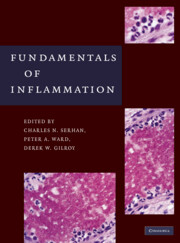Book contents
- Frontmatter
- Contents
- Contributors
- Preface
- PART I THE INFLAMMATORY RESPONSE – AN OVERVIEW
- PART II INDIVIDUAL CELL TYPES
- PART III CHEMICAL MEDIATORS
- PART IV IMMUNOPHARMACOLOGY
- PART V INFLAMMATORY DISEASES/HISTOLOGY
- 20 Lung
- 21 Neural Inflammation, Alzheimer's Disease, and Stroke
- 22 Rheumatoid Arthritis/SLE
- 23 Gastrointestinal Inflammation and Ulceration: Mediators of Induction and Resolution
- 24 Inflammatory Skin Diseases
- 25 Kidney Glomerulonephritis and Renal Ischemia
- 26 Inflammation in Cardiovascular Diseases
- PART VI ANIMAL MODELS OF INFLAMMATION
- Index
- References
25 - Kidney Glomerulonephritis and Renal Ischemia
from PART V - INFLAMMATORY DISEASES/HISTOLOGY
Published online by Cambridge University Press: 05 April 2014
- Frontmatter
- Contents
- Contributors
- Preface
- PART I THE INFLAMMATORY RESPONSE – AN OVERVIEW
- PART II INDIVIDUAL CELL TYPES
- PART III CHEMICAL MEDIATORS
- PART IV IMMUNOPHARMACOLOGY
- PART V INFLAMMATORY DISEASES/HISTOLOGY
- 20 Lung
- 21 Neural Inflammation, Alzheimer's Disease, and Stroke
- 22 Rheumatoid Arthritis/SLE
- 23 Gastrointestinal Inflammation and Ulceration: Mediators of Induction and Resolution
- 24 Inflammatory Skin Diseases
- 25 Kidney Glomerulonephritis and Renal Ischemia
- 26 Inflammation in Cardiovascular Diseases
- PART VI ANIMAL MODELS OF INFLAMMATION
- Index
- References
Summary
CASE 1
Presentation and Initial Assessment
A 64-year-old male with a history of diabetes mellitus type II, hypertension, hyperlipidemia, and known mild renal insufficiency (chronic kidney disease, stage 2) presented with fevers and chills, and worsening of kidney function (baseline plasma creatinine 1.5, increased to 1.8 mg/dL). His standing medications were modified and renal function was noted to return to baseline. One month later at follow up he reported fever, his renal function had deteriorated further with plasma creatinine level of 3.0 mg/dL, and he was found to be anemic. He received a blood transfusion and a course of antibiotics for presumed upper respiratory tract bacterial infection but one month later returned with lethargy, oliguria, and further deterioration in renal function with creatinine 4.4 mg/dL. At this point, he was referred to a nephrologist for further assessment.
At that assessment by a nephrologist, his family history was notable for thromboembolic disease, but he denied current upper or lower respiratory tract symptoms, rashes, joint pains, areas of numbness, black or red bowel movements. His medications at this presentation included Hydralazine Metoprolol Felodipine, Insulin subcutaneously, Ezetimibe, Glimepiride, Zolpidem, multi-vitamin qd, calcium, vitamin E, fish oil, and acetaminophen.
Clinical examination: weight 200 lbs, temperature 96.7F, pulse 63 beats per minute, blood pressure 160/80 mmHg, respiratory rate 20 per minute, peripheral blood oxygen saturation 97% on room air. He was a middle-aged man, pleasant, in no distress. Pupils and eye movements and oropharyngeal exams were normal.
- Type
- Chapter
- Information
- Fundamentals of Inflammation , pp. 304 - 316Publisher: Cambridge University PressPrint publication year: 2010



